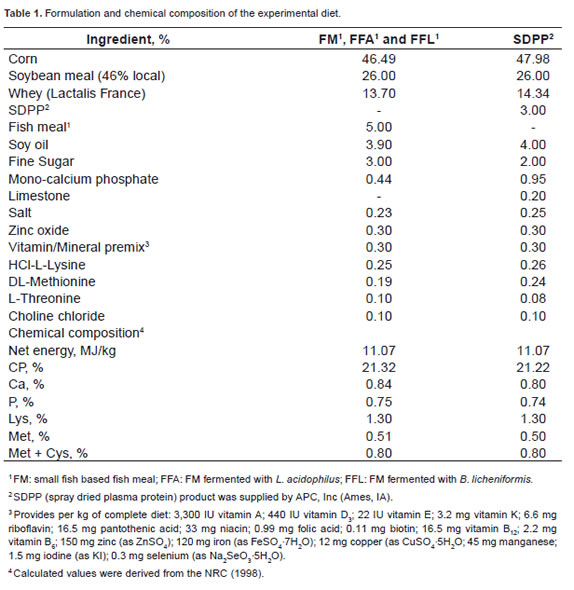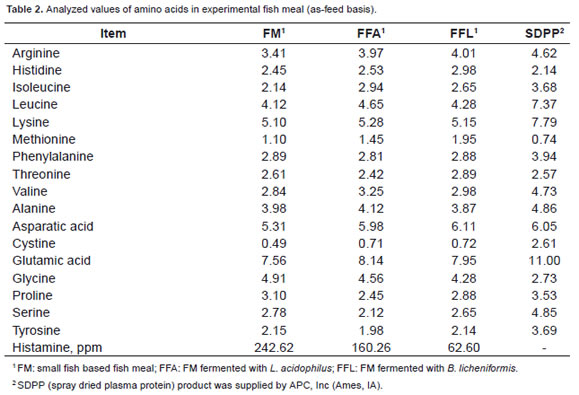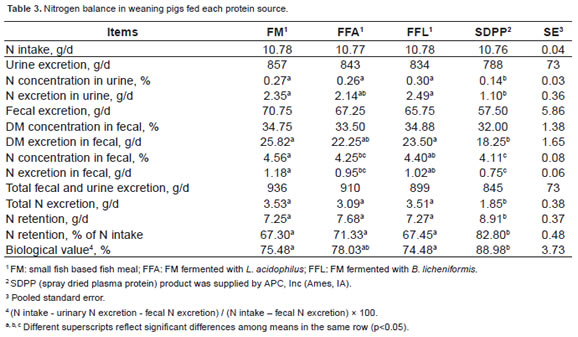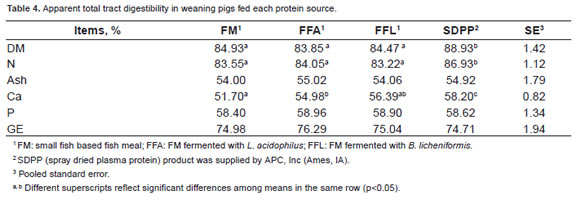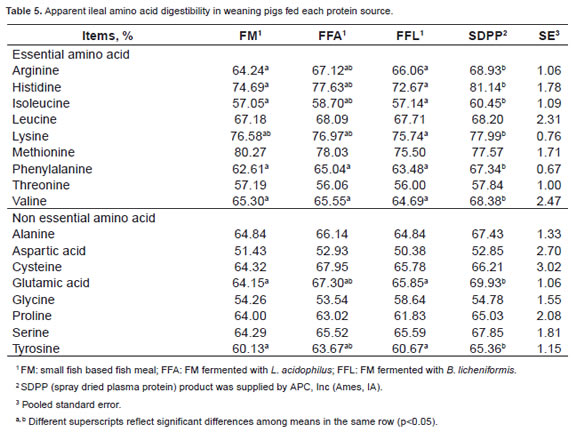Services on Demand
Journal
Article
Indicators
-
 Cited by SciELO
Cited by SciELO -
 Access statistics
Access statistics
Related links
-
 Cited by Google
Cited by Google -
 Similars in
SciELO
Similars in
SciELO -
 Similars in Google
Similars in Google
Share
Revista Colombiana de Ciencias Pecuarias
Print version ISSN 0120-0690On-line version ISSN 2256-2958
Rev Colom Cienc Pecua vol.23 no.2 Medellín Apr./July 2010
Artículos originales
Nitrogen balance and ileal nutrient digestibility in weanling pigs fed spray dried plasma protein and fermented fish meals¤
Balance de nitrógeno y digestibilidad ileal de nutrientes en cerdos destetos alimentados con proteína de plasma seco y harinas de pescado fermentadas
Balance do nitrogênio e digestibilidade ileal de nutrientes em suínos desmamados, alimentados com proteína de plasma seco e farinas de peixe fermentadas
JinHo Cho1, Animal Scientist, PhD; JongSang Yoo2 , Animal Scientist, MsC; JungHyun Ahn3,Nutrition Analyst, MsC; InHo Kim2*, Animal Scientist, PhD.
1 Department of Animal and Food Sciences, University of Kentucky, Lexington 40546-021. 2Department of Animal Resource & Sciences, Dankook University, No. 29 Anseodong, Cheonan, Choongnam, Korea. 3 National Institute of Animal Science, RDA, Suwon, Korea
(Recibido: 7 diciembre , 2009; aceptado: 20 abril, 2010)
Summary
This experiment was conducted to evaluate the effects of spray dried plasma protein (SDPP) and fermented (L. acidophilus and B. licheniformis) fish meals on nitrogen (N) balance and ileal nutrient digestibility of weanling pigs. Sixteen crossbred [(Landrace × Yorkshire) × Duroc] nursery pigs (8.58 ± 0.32 kg) were surgically fitted with a T-cannula at the distal ileum. The dietary treatments were: 1) FM (5% unfermented fish meal), 2) FFA (5% fermented fish meal with L. acidophilus), 3) FFL (5% fermented fish meal with B. licheniformis), and 4) SDPP (3% Spray dried plasma protein, AP920®, APC, Inc, Ames, IA). The N retention was greater in the SDPP treatment than in other treatments (p<0.05), and biological value was greater in the SDPP treatment than in the FM and FFL treatments (p<0.05). Dry matter (DM) and N digestibility were higher in the SDPP treatment than in other treatments (p<0.05). When calcium (Ca) digestibility was evaluated, it was found to be higher in the SDPP treatment than in the FM and FFA treatments (p<0.05). The FFA and FFL treatments had a higher calcium (Ca) digestibility than the FM treatment (p<0.05). Arginine, histidine and isoleucine digestibility were higher in the SDPP treatment than in the FM and FFL treatments (p<0.05). Lysine digestibility was higher in the SDPP treatment than in the FFL treatment (p<0.05). Compared to all dietary treatments, phenylalanine and valine digestibility were the greatest in the SDPP group (p<0.05). Glutamic acid and tyrosine digestibility were higher in the SDPP treatment than in the FM and FFL treatments (p<0.05). In conclusion, compared with feeding 3% SDPP, no positive effects were observed on N retention or nutrient digestibility in weanling pigs on the 5% fermented fish meal diets. Thus, SDPP provides a better nutrient digestibility outcome than the use of fermented fish meal.
Key words: fermentation, fish meal, ileal amino acid digestibility, nitrogen balance, weanling pigs.
Resumen
Este experimento se realizó para evaluar los efectos de la proteína de plasma seco (SDPP) y harinas de pescado fermentadas (L. acidophilus y B. licheniformis) sobre el balance de nitorgeno (N) y la digestibilidad ileal de nutrientes en cerdos al destete. Dieciséis cerdos mestizos [(Landrace × Yorkshire) × Duroc] destetos (8.58 ± 0.32kg) fueron quirúrgicamente equipados con cánulas-T en el íleon distal. Los tratamientos dietarios fueron: 1) FM (5% harina de pescado no fermentada), 2) FFA (5% harina de pescado fermentada con L. acidophilus), 3) FFL (5% de harina de pescado fermentada con B. licheniformis), y 4) SDPP (3% proteína de plasma seco, AP920®, APC, Inc, Ames, IA). La retención de N fue mayor en el tratamiento SDPP que en los otros tratamientos (p <0.05) y el valor biológico fue mayor en el tratamiento SDPP que en la FM y los tratamientos FFL (p <0.05). La digestibilidad de la materia seca (MS) y del N fue mayor en el tratamiento SDPP que en los otros tratamientos (p <0.05). Cuando se evaluó la digestibilidad del calcio (Ca), se encontró que era mayor en el tratamiento SDPP que en FM y FFA (p <0.05). Los tratamientos FFA y FFL tuvieron mayor digestibilidad del calcio que el tratamiento FM (p <0.05). La digestibilidad de la arginina, histidina e isoleucina fue mayor en el tratamiento SDPP que en los tratamientos FM y FFL (p <0.05). La digestibilidad de la lisina fue mayor en el tratamiento SDPP que en el tratamiento FFL (p <0.05). En comparación con todos los tratamientos dietarios, la digestibilidad de la fenilalanina y valina fue mayor en el grupo SDPP (p <0.05). La digestibilidad del ácido glutámico y de la tirosina fueron mayores en el tratamiento SDPP que en los tratamientos FM y FFL (p <0.05). En conclusión, en comparación con la inclusión del 3% de SDPP, no se observaron efectos positivos en la retención de N o la digestibilidad de nutrientes en cerdos destetos alimentados con 5% de harina de pescado fermentada. Por lo tanto, el SDPP proporciona una mejor digestibilidad de nutrientes que el uso de harina de pescado fermentada.
Palabras clave: balance de nitrógeno, cerdos destetos, digestibilidad ileal de aminoácidos, harina de pescado.
Resumo
O experimento foi realizado para avaliar os efeitos da proteína do plasma seco (SDPP) e de farinas de peixe fermentadas (L. acidophilus e B. licheniformis) sobre o balance do nitrogênio (N) e a digestibilidade ileal de nutrientes em suínos desmamados. Dezesseis suínos mestiços [(Landrace × Yorkshire) × Duroc] desmamados (8.58 ± 0.32kg) foram cirurgicamente equipados com cânulas-T no ileo distal. Os tratamentos foram: 1) FM (5% farina de peixe no fermentada), 2) FFA (5% farina de peixe fermentada com L. acidophilus), 3) FFL (5% de farina de peixe fermentada com B. licheniformis), e 4) SDPP (3% proteína de plasma seco, AP920®, APC, Inc, Ames, IA). A retenção de N foi maior no tratamento SDPP (p <0.05) e o valor biológico foi maior no SDPP que na FM e os tratamentos FFL (p <0.05). A digistibilidade da matéria seca (MS) e do N foi maior o tratamento SDPP (p <0.05). Quando foi avaliado a digestibilidade do cálcio (Ca), encontrou-se que foi maior no tratamento SDPP que em FM e FFA (p <0.05). Os tratamentos FFA e FFL tiveram maior digestibilidade do Ca que o tratamento FM (p <0.05). A digestibilidade da arginina, histidina e isoleucina foi maior no tratamento SDPP que nos tratamentos FM e FFL (p <0.05). A digestibilidade da lisina foi maior no tratamento SDPP que no tratamento FFL (p<0.05). A digestibilidade da fenilalanina e valina foi maior no grupo SDPP (p <0.05). A digestibilidade do ácido glutâmico e da tirosina foram maiores no tratamento SDPP que nos tratamentos FM e FFL (p <0.05). Em conclusão, a inclusão de 3% de SDPP, não tem efeito positivo na retenção de N ou a digestibiidade de nutrientes em suínos desmamados, alimentados com 5% de farina de peixe fermentada, portanto, o SDPP proporciona uma maior digestibilidade de nutrientes que o uso de farina de peixe fermentada.
Palavras chave: balance de nitrogênio, digestibilidade ileal de aminoácidos, farina de peixe, suinos.
¤ Para citar este artículo: Cho JH, Yoo JS, Ahn JH, Kim IH. Nitrogen Balance and Ileal Nutrient Digestibility in Weanling Pigs Fed Spray Dried Plasma Protein and Fermented Fish Meals. Rev Colomb Cienc Pecu 2010; 137-144.
* Corresponding Author. KIM IH. Department of Animal Resource & Sciences, Dankook University, No. 29 Anseodong, Cheonan, Choongnam 330-714, Korea, Tel: +82-41-550-3652, E-mail: inhokim@dankook.ac.kr.
Introduction
Spray dried plasma protein (SDPP) is a protein source that has a balanced amino acid profile and immunoglobulins. When young pigs consume a diet containing SDPP, the results include increased growth performance (daily gain, feed intake and feed efficiency) (Gatnau and Zimmerman, 1990; Hansen et al., 1993; Kats et al., 1994) and reductions in the extent and severity of diarrhea (Coffey and Cromwell, 2001; van Dijk et al., 2001). However, these protein sources are expensive, and consequently must improve growth performance appreciably in order to be cost effective.
Fish meal is traditionally recognized as a very digestible protein that has a high concentration of amino acids, vitamins, and minerals (Kim and Easter, 2001). Stoner et al. (1990) reported that replacing a portion of the soybean meal in a starter diet with select menhaden fish meal resulted in improved average daily gain (ADG), average daily feed intake (ADFI), and gain to feed ratio. Certain low quality fish meals may contain high levels of histamine, a biogenic amine attributed to food poisoning in poultry (KoÈ se, 1993). Shifrine et al. (1959) demonstrated that high histamine levels resulted in reduced growth rates and depression among chicks.
Dapkevicius et al. (2000) demonstrated that fish waste could be reprocessed into animal feed by fermentation with lactic acid bacteria (LAB). Leuschner et al. (1998) reported that microorganisms, (Brevibacterium linens, Staphylococcus carno, Geotrichum candidum, and Micrococcus varians) which were suitable for food fermentation were also effective in degrading histamine in food. We hypothesized that fermented fish meal would serve as an optimal protein source for weanling pigs. Therefore, the current study was designed to evaluate the use of SDPP and fermented (L. acidophillus and B. licheniformis) fish meals on N balance and ileal nutrient digestibility in weaned pigs.
Materials and methods
The Animal Care and Use Committee of Dankook University approved all of the experimental protocols conducted in the current study.
Experimental design, animals, and diets
Sixteen crossbred [(Landrace × Yorkshire) × Duroc] pigs (8.5 ± 0.3 kg) were fasted for 16 hours and then surgically fitted with T-cannulas approximately 15 cm proximal of the ileo-cecal junction. Anesthesia was induced using injected StresnilTM (Janssen Pharmaceutica, Belgium) and Virbac Zoletil 50 (Virbac Laboratory, France). Following surgery, the barrows were housed individually in stainless steel metabolism crates within a temperature controlled (28 °C) room. The pigs were then permitted 14 d of recovery prior to the initiation of the experiment. The pigs were blocked based on their initial body weight and then randomly allocated to one of four dietary treatments in a randomized complete block design that included four replications per treatment. The daily feed allowance, which was 0.05 ´ BW0.9, was fed in two meals at 12 h intervals (0600 and 1800). The experimental period also included 7 d of adjustment to the experimental diets and 2 d (12 h/d) of ileal digesta collection.
Dietary treatments were as follows: 1) FM (5% unfermented fish meal), 2) FFA (5% fermented fish meal with L. acidophilus), 3) FFL (5% fermented fish meal with B. licheniformis) and 4) SDPP (3% Spray-dried plasma protein, AP920®, APC, Inc, Ames, IA). The ingredients and nutrient compositions of the diets are provided in table 1. The diets were formulated to meet or exceed the nutrient requirements recommended by the NRC (1998).
Sampling and Analysis
To evaluate the ileal nutrient digestibility, chromic oxide (Cr2O3) was added at a level of 0.20% of the diet as an indigestible marker from the initial day of the experiment. Fresh fecal samples were collected from the crates for 2 days (on day 10 and 11), with the samples being dried and pooled for subsequent analysis following collection. In addition, urine samples were collected by placing a bucket under the crates, added with 100 ml of 10% HCL. The total urine volumes were recorded each day, and 10% of the urine was frozen for later analysis to determine the N concentration. The ileal digesta was collected between 0600 and 1800 for 2 days (on d 8 and 9) continuously by attaching a transparent 100-ml latex collection bag to the cannulas. During the 12-h collection period, digesta were collected every 30 min and then immediately frozen. At the conclusion of the experimental collection period, the digesta collected from each pig during the respective periods were homogenized and a 200-g subsample was obtained. Feed, feces and ileal samples were then freeze-dried and finely (1 mm) ground prior to analysis for chromium (AOAC, 1995). The chromium concentration was determined via UV absorption spectrophotometry (Shimadzu, UV-1201, Japan), and the apparent digestibility was then calculated via indirect methods. In addition, the amino acid digestibility of the experimental feed was determined after 24 hours of acid hydrolysis with 6N HCl at 110 °C using an amino acid analyzer (Biochrom 20, Pharmacia Biotech, England). The sulfur-containing amino acids were analyzed following cold performic acid oxidation overnight and subsequent hydrolysis. The fish; drying temperature: 80 °C), FFA and FFL gross energy was analyzed using an oxygen bomb (fermented small fish; drying temperature: 60 °C) calorimeter (Parr, 6100, USA). were evaluated in weanl ing pigs. The analyzed values of amino acid and histamine of fish meals are shown in table 2. The L. acidophillus and B.
Fish Meals
licheniformis were selected from MRS broth agar Three types of fish meal were prepared for and Luria-Bertani, Miller (BD, USA), respectively, this experiment: FM, FFA and FFL. FM (small after being selected from fresh or salted fish.
Statistical Analysis
In this experiment, all data were analyzed using a randomized complete block design following GLM procedures of SAS (SAS Inst. Inc., Cary, NC), with each pen being used as the experimental unit. The treatment means were compared by using Duncan's multiple range test (Duncan, 1955). Variability in the data was expressed as the SE of the mean and the selected level of significance was set at 0.05.
Results
Nitrogen Balance
N balance and biological values are provided in table 3. N concentration in urine was the lowest in the SDPP treatment among treatments (p<0.05). N excretion in urine and DM excretion in fecal were lower in the SDPP treatment than the FM and FFL treatments (p<0.05). The SDPP treatment had a lower N concentration and excretion in the feces than the FM and FFL treatments (P<0.05). The FFA treatment had a lower N concentration and excretion in the feces than the FM treatment (p<0.05). When the total N excretion was evaluated, it was found to be lower in the SDPP treatment compared to the other treatments (p<0.05). N retention was greater in the SDPP treatment than in other treatments (p<0.05) and the biological value was greater in the SDPA treatment than in the FM and FFL treatments (p<0.05).
Apparent Total Tract Digestibility of Nutrientsand leal Amino Acid Digestibility
Apparent total tract nutrient digestibility is shown in table 4. DM and N digestibility were higher in the SDPP treatment than in other treatments (p<0.05). When Ca digestibility was evaluated, it was found to be higher in the SDPP treatment than in the FM and FFA treatments (p<0.05). The FFA and FFL treatments had a higher Ca digestibility than FM treatment (p<0.05).
Apparent ileal amino acid digestibility is (p<0.05). Phenylalanine and valine digestibility provided in table 5. Arginine, histidine and were the greatest in the SDPP treatment among isoleucine digestibility were higher in the SDPP all treatments (p<0.05). Glutamic acid and treatment than in the FM and FFL treatments tyrosine digestibility were higher in the SDPP (p<0.05). Lysine digestibility was higher in treatment than in the FM and FFL treatments the SDPP treatment than in the FFL treatment (p<0.05).
Discussion
Fermented foods have been consumed by humans in Southeast Asian countries, but food fermentation technology remains limited with regard to its application in animal production sector. Fermented diets might improve daily gain, feed intake, and the feed conversion ratio in pigs in comparison with non-fermented diets. Fermented diets contain high levels of organic acids and may be an alternative for the prophylactic use of antimicrobial growth promoters in pig diets (Scholten et al., 1999). Feeding a fermented diet minimizes the time available for the gastrointestinal microflora to decarboxylate free amino acids present in the diet, which has shown to improve growth performance in pigs (Scholten, 2001; Pedersen et al., 2002; Pedersen, 2006). Pedersen and Lindberg (2003) also reported an improvement in the in vitro digestibility of organic matter and crude protein due to fermentation. Hong and Lindberg (2007) demonstrated that the total tract apparent digestibility of crude protein was higher (p<0.05) in a fermented diet than in raw and cooked diets.
A promising area for future research would be analyzing the effects of feeding liquid feed containing fermented liquid cereal grains as a means of avoiding microbial decarboxylation of free amino acids and increasing feed intake by improving palatability (Canibe et al., 2007).
Also, fish waste could be upgraded into animal feed by fermentation with lactic acid bacteria (Dapkevicius et al., 2000). The authors hypothesized that fish meal containing a high level of histamine would improve the nutritional value for weaned pigs by fermentation. Although fermentation reduced histamine concentration in experimental fish meals, the present study could not find the enhanced benefits of fermented fish meal relative to feeding SDPP, because SDPP is a protein source that has a balanced amino acid profile (Table 2) compared with experimental fish meals. In conclusion, compared to feeding 3% SDPP, no positive effects were observed on N retention or nutrient digestibility in weanling pigs on 5% fermented fish meal diets. Thus, SDPP provides a better nutrient digestibility outcome than the use of fermented fish meal.
References
1. AOAC. Official method of analysis. 16th Edition. Association of Official Analytical Chemists, Washington, DC; 1995. [ Links ]
2. Bergsröm JR, Nelssen JL, Tokach MD, Goodband RF, Dritz SS, Owen KQ, Nessmith Jr WB. Evaluation of spray-dried animal plasma and select menhaden fish meal in transition diets of pigs weaned at 12 to 14 days of age and reared in different production systems. J Anim Sci 1997; 75:3004-3009. [ Links ]
3. Canibe N, Højberg O, Badsberg JH, Jensen BB. Effect of feeding fermented liquid feed and fermented grain on gastrointestinal ecology and growth performance in piglets. J Anim Sci 2007; 85:2959-2771. [ Links ]
4. Coffey RD, Cromwell GL. The impact of environment and ntimicrobial agents on the growth response of early-weaned pigs to spray-dried porcine plasma. J Anim Sci 1995; 73:2532-2539. [ Links ]
5. Coffey RD, Cromwell GL. Use of spray-dried animal plasma in diets for weanling pigs. Pig News Inf 2001; 22:39N. [ Links ]
6. Dapkevicius MLNE, Nout MJR, Rombouts FM, Houben JH, Wymenga W. Biogenic amine formation and degradation by potential fish silage starter microorganisms. Int J Food Microbiol 2000; 57:107-114. [ Links ]
7. DeRouchey JM, Tokach MD, Nelssen JL, Goodband RD, Dritz SS, Woodworth JC, James BW, Webster MJ, Hastad CW. Evaluation of methods to reduce bacteria concentrations in spray-dried animal plasma and its effects on nursery pig performance. J Anim Sci 2004; 82:250-261. [ Links ]
8. Duncan DB. Multiple range and multiple F test. Biometrics 1995; 11:1-42. [ Links ]
9. Everts H, Van Beers-Schreurs HMG, Vellenga, L. Diet in relation to weaning problems in piglets. Tijdschr. Diergeneesk 1999; 124:44-47. [ Links ]
10. Gatnau R, Zimmerman DR. Spray dried porcine plasma (SDPP) as a source of protein for weanling pigs. J Anim Sci 1990; 68:374. [ Links ]
11. Hansen JA, Nelssen JL, Goodband RD, Weeden TL. Evaluation of animal protein supplements in diets of early weaned pigs. J Anim Sci 1993; 71:1853-1862. [ Links ]
12. Hong TTT, Lindberg JE. Effect of cooking and fermentation of a pig diet on gut environment and digestibility in growing pigs. Livest Sci 2007; 109:135-137. [ Links ]
13. Kats LJ, Nelssen JL, Tokach MD, Goodband RD, Hansen JA, Laurin KL. The effect of spray-dried porcine plasma on growth performance in the early-weaned pig. J Anim Sci 1994; 72:2075-2081. [ Links ]
14. Kim SW, Easter RA. Nutritional value of fish meals in the diet for young pigs. J Anim Sci 2001; 79:1829-1839. [ Links ]
15. KoE Se S. Investigation into toxins and pathogens implicated in fish meal production. PhD thesis, Loughborough University of Technology, Leicestershire, UK; 1993. [ Links ]
16. Leuschner RG, Martina H, Hammes WP. Histamine and tyramine degradation by food fermenting microorganisms. Int J Food Microbiol 1998; 39:1-10. [ Links ]
17. NRC. Nutrient requirement of pigs (10th Edition) National Research Council, Academy Press. Washington, DC; 1998. [ Links ]
18. Pedersen AØ. Fermented grain to piglets. Danish bacon and meat council, no. 728. (In Danish). Copenhagen, Denmark; 2006. [ Links ]
19. Pedersen AØ, Maribo H, Jensen BB, Hansen ID, Aaslyng MD. Fermented grain added to liquid feed to heavy pigs. Danish Bacon and Meat Council, no. 547. (In Danish). Copenhagen, Denmark; 2002. [ Links ]
20. Pedersen C, Lindberg JE. Effect of fermentation in a liquid diet on nitrogen metabolism in growing pigs. EAAP Publication 2003; 109:641-644. [ Links ]
21. Pierce JL, Cromwell GL, Lindemann MD, Russell LE, Weaver EM. Effects of spray-dried animal plasma and immunoglobulins on performance of early weaned pigs. J Anim Sci 2005; 83:2876-2885. [ Links ]
22. SAS. SAS user's guide. Release 6.12 edition. SAS Inst Inc Cary NC. USA; 1996. [ Links ]
23. Scholten RHJ, van der Peet-Schwering CMC,Verstegen MWA, den Hartog LA, Schrama JW, Vesseur PC. Fermented coproducts and fermented compound diets for pigs: a review. Animal Feed Science and Technology 1999; 82:1-19. [ Links ]
24. Scholten R. Fermentation of liquid diets for pigs. PhD Thesis. Wageningen University, the Netherlands; 2001. [ Links ]
25. Shifrine M, Ousterhout E, Grau R, Vaughan HH. Toxicity to chicks of histamine formed during microbial spoilage of tuna. Appl Microbiol 1959; 7:45-50.
26. Stoner GR, Allee GL, Nelssen JL, Johnston ME, Goodband RD. Effect of select menhaden fish meal in starter diets for pigs. J Anim Sci 1990; 68:2729-2735. [ Links ]
27. Van Dijk AJ, Everts PH, Nabuurs MJA, Margry RJCF, Beynen AC. Growth performance of weanling pigs fed spray-dried animal plasma: A review. Livest Prod Sci 2001; 68:263-274. [ Links ]
28. Xu RJ, Cranwell P. The neonatal pigs- gastrointestinal physiology nutrition. Notingham University Press 2003; p.249. [ Links ]













